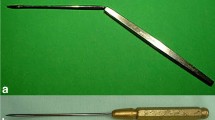Abstract
Background
Facial fat grafting under local anesthesia has been widely performed in outpatient departments and private settings in China. The present study aimed to evaluate the safety and efficacy of facial fat grafting under local anesthesia.
Method
A retrospective study was conducted on 155 patients who underwent facial fat grafting. The clinical data were recorded. Preoperative and postoperative two-dimensional images were acquired to evaluate the effect of facial fat grafting on refining facial contouring, rejuvenation as well as deformity reconstruction. The complications were recorded to assess the safety of the approach.
Result
All the facial fat grafting procedures were performed successfully under local anesthesia. A majority of the patients who underwent one or more sessions of facial fat grafting under local anesthesia were satisfied with the cosmetic results. No severe complications occurred in these patients.
Conclusions
In the present study, remarkable and natural improvements of facial contouring, rejuvenation as well as deformity reconstruction were achieved with facial fat grafting in most patients. Thus, the procedures performed under local anesthesia by experienced surgeons are safe.
Level of Evidence IV
This journal requires that authors assign a level of evidence to each article. For a full description of these Evidence-Based Medicine ratings, please refer to the Table of Contents or the online Instructions to Authors www.springer.com/00266.




Similar content being viewed by others
References
Butz DR, Gill KK, Randle J et al (2016) Facial aesthetic surgery: the safe use of oral sedation in an office-based facility. Aesthet Surg J 36:127–131
Bitar G, Mullis W, Jacobs W et al (2003) Safety and efficacy of office-based surgery with monitored anesthesia care/sedation in 4778 consecutive plastic surgery procedures. Plast Reconstr Surg 111:150–156 (discussion 157–158)
Byrd HS, Barton FE, Orenstein HH et al (2003) Safety and efficacy in an accredited outpatient plastic surgery facility: a review of 5316 consecutive cases. Plast Reconstr Surg 112:636–641 (discussion 642–636)
Carruthers JD, Fagien S, Rohrich RJ et al (2014) Blindness caused by cosmetic filler injection: a review of cause and therapy. Plast Reconstr Surg 134:1197–1201
Yoshimura K, Coleman SR (2015) Complications of fat grafting: how they occur and how to find, avoid, and treat them. Clin Plast Surg 42:383–388
Gamboa GM, Ross WA (2013) Autologous fat transfer in aesthetic facial recontouring. Ann Plast Surg 70:513–516
Malavasi LM, Greene SA, Gay JM et al (2016) Cardiopulmonary effects of constant-rate infusion of lidocaine for anesthesia during abdominal surgery in goats. J Am Assoc Lab Anim Sci 55:431–435
Morello DC, Colon GA, Fredricks S et al (1997) Patient safety in accredited office surgical facilities. Plast Reconstr Surg 99:1496–1500
Jiang T, Xie Y, Zhu M et al (2016) The second fat graft has significantly better outcome than the first fat graft for Romberg syndrome: a study of three-dimensional volumetric analysis. J Plast Reconstr Aesthet Surg 69:1621–1626
Moore JH Jr., Kolaczynski JW, Morales LM et al (1995) Viability of fat obtained by syringe suction lipectomy: effects of local anesthesia with lidocaine. Aesthet Plast Surg 19:335–339
Shoshani O, Berger J, Fodor L et al (2005) The effect of lidocaine and adrenaline on the viability of injected adipose tissue—an experimental study in nude mice. J Drugs Dermatol 4:311–316
Smith P, Adams WP Jr., Lipschitz AH et al (2006) Autologous human fat grafting: effect of harvesting and preparation techniques on adipocyte graft survival. Plast Reconstr Surg 117:1836–1844
Livaoglu M, Buruk CK, Uraloglu M et al (2012) Effects of lidocaine plus epinephrine and prilocaine on autologous fat graft survival. J Craniofac Surg 23:1015–1018
Keck M, Janke J, Ueberreiter K (2007) The influence of different local anaesthetics on the viability of preadipocytes. Handchir Mikrochir Plast Chir 39:215–219
Keck M, Zeyda M, Gollinger K et al (2010) Local anesthetics have a major impact on viability of preadipocytes and their differentiation into adipocytes. Plast Reconstr Surg 126:1500–1505
Girard AC, Atlan M, Bencharif K et al (2013) New insights into lidocaine and adrenaline effects on human adipose stem cells. Aesthet Plast Surg 37:144–152
Peer LA (1955) Cell survival theory versus replacement theory. Plast Reconstr Surg 16:161–168
Khouri RK, Rigotti G, Cardoso E et al (2014) Megavolume autologous fat transfer: part I. Theory and Principles. Plast Reconstr Surg 133:550–557
Yoshimura K, Eto H, Kato H et al (2011) In vivo manipulation of stem cells for adipose tissue repair/reconstruction. Regen Med 6:33–41
Zhu M, Xie Y, Zhu Y et al (2016) A novel noninvasive threedimensional volumetric analysis for fat-graft survival in facial recontouring using the 3L and 3M technique. J Plast Reconstr Aesthet Surg 69:248–254
Yu NZ, Huang JZ, Zhang H et al (2015) A systemic review of autologous fat grafting survival rate and related severe complications. Chin Med J (Engl) 128:1245–1251
Kim YK, Jung C, Woo SJ et al (2015) Cerebral angiographic findings of cosmetic facial filler-related ophthalmic and retinal artery occlusion. J Korean Med Sci 30:1847–1855
Acknowledgements
This work was supported by Science and Technology Innovation Project of Shanghai Jiao Tong University School of Medicine (No. 16XJ21004), and the Research Project of Shanghai Municipal Health Bureau (No. 201540374).
Author information
Authors and Affiliations
Corresponding author
Ethics declarations
Conflict of interest
The authors do not have any possible conflict of interest.
Additional information
Xiaorong Ma and Liming Wu contributed equally to this work and should be considered as co-first authors.
Rights and permissions
About this article
Cite this article
Ma, X., Wu, L., Ouyang, T. et al. Safety and Efficacy of Facial Fat Grafting Under Local Anesthesia. Aesth Plast Surg 42, 151–158 (2018). https://doi.org/10.1007/s00266-017-1000-2
Received:
Accepted:
Published:
Issue Date:
DOI: https://doi.org/10.1007/s00266-017-1000-2




